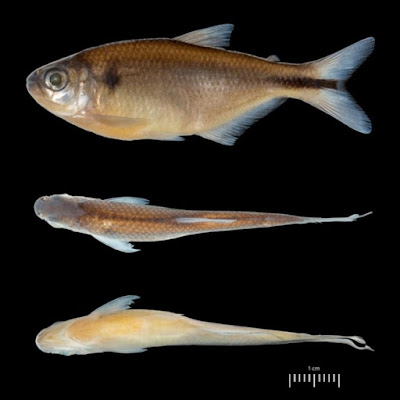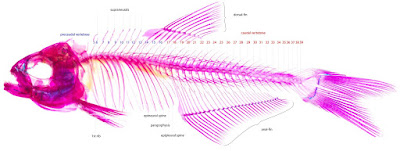[Most Recent Entries] [Calendar View]
Thursday, April 19th, 2018
| Time | Event | ||||
| 6:03a | [Ichthyology • 2018] Hemibrycon iqueima • A New Species of Hemibrycon (Characiformes, Characidae, Stevardiinae) from the upper Magdalena River Basin in Colombia
Abstract Hemibrycon iqueima sp. nov., is described from small streams in the Magdalena drainage at the foothills of the western slope of the Eastern Cordillera of the Colombian Andes, Suarez municipality, Tolima Department, Colombia. The new species is distinguished from its congeners in the Magdalena–Cauca River basin by a combination of characters related to snout–anal‐fin origin length, head length, dorsal–pectoral fin distance, dorsal‐fin–hypural distance, postorbital distance, orbital diameter, snout length, number of total vertebrae, pre‐dorsal scales, scale rows between anal‐fin origin and lateral line, number of branched rays of the anal fin, maxillary teeth number and number and arrangement of hooks on the branched rays of the pectoral and dorsal fins. In addition, the validity of this species is supported by previous molecular analyses that included specimens of the new species that had been erroneously identified. Phylogenetic relationships between the new species and congeners from Pacific coast basins are discussed. Key words: biodiversity; ichthyology; morphological visualization; Neotropical fishes; Stevardiinae; taxonomy
Hemibrycon iqueima sp. nov. Distribution and habitat: Hemibrycon iqueima is known from three small tributaries (Batatas, Yeguas, Bacallá) in the upper Magdalena River basin, draining the western slope of the Eastern Cordillera (Figs 5 and 6). Etymology: The specific epithet is a noun in apposition referring to Cacique Iqueima, a name belonging to the indigenous Los Panches and Tolimas tribes that inhabited the type locality region. The tribes inhabited land near to the Magdalena River south-west of Cundinamarca and north-east of Tolima. J. E. García‐Melo, J. G. Albornoz‐Garzón, L. J. García‐Melo, F. A. Villa‐Navarro and J. A. Maldonado‐Ocampo. 2018. A New Species of Hemibrycon (Characiformes, Characidae, Stevardiinae) from the upper Magdalena River Basin in Colombia. Journal of Fish Biology. DOI: 10.1111/jfb.13634 | ||||
| 6:17a | [Marine Mammal • 2018] Large Dugong (Dugong dugon) Aggregations Persist in coastal Qatar
Dugongs (Dugong dugon) are large herbivorous marine mammals of the order Sirenia commonly referred to as sea cows. Due to their herbivorous diet, feeding and foraging dominate their natural history. Dugongs have evolved a specialized feeding apparatus for efficient grazing and processing of sea grass, which can occur by cropping blades or the excavation of roots and rhizomes (Marsh et al. 1999; Marshall et al. 2003; Lanyon and Sanson 2006a, b). The excavation of seagrasses results in signature benthic feeding trails in which 60%–90% of the vegetation may be removed (Heinsohn et al. 1977; Preen 1992, 1995; Marsh et al. 2011). Sediment plumes from dugong foraging are easily observed during aerial surveys. Due to their low reproductive output, dugongs are vulnerable to perturbations in their environment, such as habitat degradation, fisheries bycatch and contaminants (Baldwin and Cockcroft 1997, Marsh et al. 2011, Reynolds and Marshall 2012) from which populations may be slow to recover. Dugongs of the Arabian Gulf are consistently referred to as the largest population outside Australia, and the Gulf has been cited as the most important region for dugongs in the western portion of their range (Marsh et al. 2002, 2011). These statements are based on extensive surveys conducted 30 yr ago in which the entire Arabian Gulf population was estimated at approximately 6,000 dugongs (Preen 1989, 2004; Preen et al. 2012). .... .... Christopher D. Marshall, Mehsin Al Ansi, Jennifer Dupont, Christopher Warren, Ismail Al Shaikh and Joshua Cullen. 2018. Large Dugong (Dugong dugon) Aggregations Persist in coastal Qatar. Marine Mammalogy. DOI: 10.1111/mms.12497 Dugongs in the Arabian Gulf comprise the second largest population in the world. Check out our new work in Mar Mamm Sci on persistent aggregations of dugongs off of NW Qatar onlinelibrary.wiley.com/journal/10.1111/ Our article "Large Dugong (Dugong dugon) Aggregations Persist in Coastal Qatar" is publ in MarMammSci Early View. 500+ dugongs aggregate in NW Qatar seasonally-largest single group in the world. 1st known 30 yrs ago, this aggregation persists today @AggiesByTheSea @tamuresearch | ||||
| 10:05a | [PaleoMammalogy • 2018] Macrosqualodelphis ukupachai • A New Large Squalodelphinid (Cetacea, Odontoceti) from Peru Sheds Light on the Early Miocene Platanistoid Disparity and Ecology
Abstract The South Asian river dolphin (Platanista gangetica) is the only extant survivor of the large clade Platanistoidea, having a well-diversified fossil record from the Late Oligocene to the Middle Miocene. Based on a partial skeleton collected from the Chilcatay Formation (Chilcatay Fm; southern coast of Peru), we report here a new squalodelphinid genus and species, Macrosqualodelphis ukupachai. A volcanic ash layer, sampled near the fossil, yielded the 40Ar/39Ar age of 18.78 ± 0.08 Ma (Burdigalian, Early Miocene). The phylogenetic analysis places Macrosqualodelphis as the earliest branching squalodelphinid. Combined with several cranial and dental features, the large body size (estimated body length of 3.5 m) of this odontocete suggests that it consumed larger prey than the other members of its family. Together with Huaridelphis raimondii and Notocetus vanbenedeni, both also found in the Chilcatay Fm, this new squalodelphinid further demonstrates the peculiar local diversity of the family along the southeastern Pacific coast, possibly related to their partition into different dietary niches. At a wider geographical scale, the morphological and ecological diversity of squalodelphinids confirms the major role played by platanistoids during the Early Miocene radiation of crown odontocetes. KEYWORDS: Odontoceti, Squalodelphinidae, Early Miocene, Peru, phylogeny, palaeoecology Systematic palaeontology Cetacea Brisson, 1762 Neoceti Fordyce and Muizon, 2001 Odontoceti Flower, 1867 Platanistoidea Gray, 1863 Squalodelphinidae Dal Piaz, 1917 Type genus. Squalodelphis Dal Piaz, 1917 Other genera included. Huaridelphis, Medocinia, Notocetus, Phocageneus. Macrosqualodelphis, gen. nov. Etymology. From ‘Macro’, large, and ‘Squalodelphis’ the type genus of the family. Gender masculine. Macrosqualodelphis ukupachai, sp. nov. Holotype and only referred specimen. MUSM 2545 consists of a skull lacking the anterior portion of the rostrum, the ear bones, both mandibles and the hyoid bones. The ventralmost portion of the rostrum and of the basicranium is worn along a plane slightly anterodorsally sloping with respect to the horizontal plane of the skull (erupted portion of maxillary teeth, basioccipital crests, ventral part of exoccipitals and postglenoid processes of squamosals missing). MUSM 2545 also preserves three detached anterior teeth; the atlas, two thoracic, two lumbar and eight caudal vertebrae; the left humerus, radius and incomplete ulna; one phalanx and one metacarpal; and two small fragments of ribs. Type locality. About 3 km south of the fossiliferous Cerro Colorado locality, Western Ica Valley, Ica Region, southern Peru. 710 m above sea level. The holotype was discovered and collected by one of the authors (M.U.). Etymology. From ‘Uku Pacha’ (Uku = within, inside; Pacha = Earth), the Inca lower world, located below the Earth's surface, in reference to the discovery of the specimen buried in sediment. Conclusion: Macrosqualodelphis ukupachai is a new species of the extinct platanistoid family Squalodelphinidae based on a well-preserved partial skeleton collected from the Early Miocene (ca 19–18 Ma) fossiliferous beds of the Chilcatay Fm outcropping in the Western Ica Valley (southern coast of Peru). The age of this skeleton is further constrained via 40Ar/39Ar dating of a local volcanic ash layer to 18.78 ± 0.08 Ma (early Burdigalian). Our phylogenetic analysis supports the referral of M. ukupachai to the monophyletic family Squalodelphinidae, of which it constitutes the earliest diverging lineage. The main distinctive character of M. ukupachai is its large size: its estimated TBL is approximately 3.5 m, significantly larger than all other known squalodelphinids, including N. vanbenedeni (2.5 m) and H. raimondii (2.0 m), both also found in the Chilcatay Fm. Combined with cranial and dental features (robust rostrum less tapered than in other squalodelphinids, large temporal fossa, prominent nuchal and temporal crests, and more robust teeth), the large body size of M. ukupachai suggests that this squalodelphinid was able to prey upon larger prey items. Consequently, M. ukupachai would have been positioned higher along the local trophic chain than the roughly contemporaneous N. vanbenedeni and H. raimondii. Therefore, it is suggested that the squalodelphinid diversity, both locally and worldwide, could be related to their partition into different dietary niches, as is observed in the extant delphinids. This new record further illustrates the first, Early Miocene, broad radiation of crown odontocetes in marine environments, with a major contribution of homodont platanistoids. This Early Miocene morphological and ecological diversification of platanistoids (including squalodelphinids) was followed by the radiation of delphinidans (porpoises, true dolphins and relatives) during the Middle–Late Miocene. The only extant survivor of the platanistoid ‘golden age’ is the endangered South Asian river dolphin P. gangetica, confined in freshwater ecosystems of the Ganges, Indus and Brahmaputra river basins. Giovanni Bianucci, Giulia Bosio, Elisa Malinverno, Christian de Muizon, Igor M. Villa, Mario Urbina and Olivier Lambert. 2018. A New Large Squalodelphinid (Cetacea, Odontoceti) from Peru Sheds Light on the Early Miocene Platanistoid Disparity and Ecology. Royal Society Open Science. 5(4) DOI: 10.1098/rsos.172302 |
| << Previous Day |
2018/04/19 [Calendar] |
Next Day >> |












